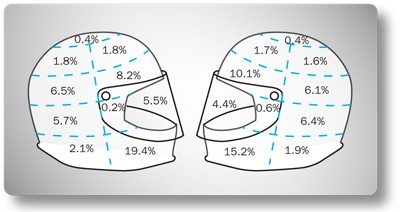Helmets: Use Your Head
- August 20, 2016
- Uncategorized
- Posted by admin
- Comments Off on Helmets: Use Your Head
In the state of California and 19 other states or districts, it is illegal to ride a motorcycle without a helmet, and for good reason: head injury is among the most traumatic and common injuries in serious or fatal motorcycle crashes. Wearing a helmet can reduce the chances of a fatality by about 37% and the odds of brain injury by 67%, according to the Insurance Institute for Highway Safety. So when you go out and buy a new helmet, here’s what you need to know to ensure that you’ll be as safe as possible.
One Time Use
Every rider should know that helmets are built to protect riders from one single crash. After a strong impact, helmets lose their value and protection and should be replaced as soon as possible. Even dropping the helmet from as low as hip-level could sometimes break the inner protective lining, depending on how the helmet landed and on what surface. Even if there is no damage to the exterior, the protective lining could be damaged.
Type
Among all the different types of motorcycle helmets, full-face helmets are the safest. Studies have shown the the chin and jaw are the most likely parts of the head to experience an impact, as shown in the picture below. Modular or flip-up helmets might seem good enough for the job, but sometimes chinbar latches can fail, making them no better than a 3/4 helmet and exposing the most likely area to sustain impact. Full-face helmets are the most popular type for a reason.
Fit
Another important factor in helmet safety is fit. It cannot be too tight around the forehead, temples, or back of the head, as over prolonged periods this can lead to headaches and possibly bruising. Tightness around the cheeks is perfectly fine, as long as the rider is comfortable. If a helmet is uncomfortable, it can become a distraction to the rider and divert attention from the road. To ensure that your helmet fits correctly, put it on, secure the chin strap, and perform what is called “the roll test.” Reach up, then bend the elbow until you grab the lower edge of the helmet behind your neck. Give the helmet a strong yank to try and roll it off. If it shifts position or slightly rolls off, then it is not a good fit. If it stays exactly in place, then it passed the roll test! Passing this test ensures that the helmet will stay on in a crash and perform the way it was designed.
Certification
There are three different kinds of certifications that you might find on your helmet, depending on which organization approved that design. The most common (and mandatory) one is a DOT sticker, which is short for the US Department of Transportation. This approval means that it can protect against some blunt trauma. The tests for DOT approval have not changed too much in the last few decades, unlike the other common certification from the Snell Foundation. Helmets that are Snell approved have passed more expensive and often updated testing, including protection against punctures. There is endless debate over which organization’s approval is more important, but spending a bit more on safety is always a good investment. The last organizational approval is from Europe and is labeled ECE, which is very similar to the DOT standard. This sticker is much less common, but could still come up every now and then.
Before riding any of our sport or supersport bikes, we highly recommend that you invest in a good helmet that will protect you. There’s a reason the law requires one.

